Hound Breed Information
Treeing Walker
|
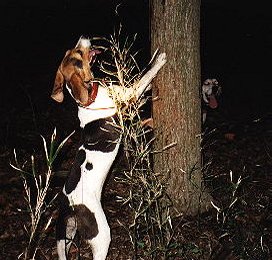
The Treeing Walker was developed from certain strains of English Walker Foxhounds. The credit for the development of the Walker Foxhound goes to two men - George Washington Maupin and John W. Walker. Both men were from Kentucky.
Before that time Thomas Walker of Albemarle County, Virginia, imported hounds from England in 1742. George Washington, who was an avid fox hunter, also imported several hounds from England in 1770. These dogs became the foundation strains of the "Virginia hounds", which were developed into the Walker hounds.
At least one major outcross was made in the 19th century that was to forever influence the breed. Strangely, the outcross was with a stolen dog from Tennessee of unknown origin, known as "Tennessee Lead."
Lead didn't look like the Virginia strain of English Foxhounds of that day. But he had an exceptional amount of game sense, and plenty of drive and speed and a clear, short mouth.
Walkers were first registered with U.K.C. as part of the English Coonhound breed. Then in 1945, at the request of Walker breeders, U.K.C. began registering them as a separate breed - first as Walkers (Treeing) and then later as Treeing Walkers.
|
American Black & Tan
|
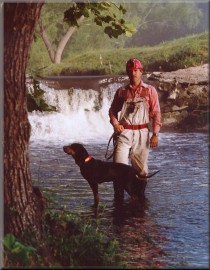
The Black & Tan is one of many tracking breeds that was developed in the south of the United States. The breed can trace its immediate ancestry to the American Foxhound and the Virginia Foxhound of colonial days, with probably the introduction of some Bloodhound stock. This latter would explain not only the coloration of the Black & Tan, but its tendency toward being larger-boned than other breeds, its long ears, and its famous cold nose.
The American Black & Tan can probably be traced to the English Foxhounds, and before that to the Tolbot Hounds and St. Hubert hounds of France. These hounds were first brought to England following the Norman invasion in the 11th Century.
The American Black & Tan was the first coonhound breed to be admitted into registry with U.K.C. When they were first registered in 1900, and for several years after that, they were registered was American Black & Tan Fox Coonhounds.
|
Bluetick
|
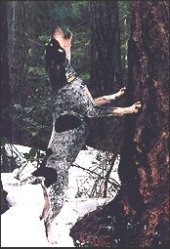 It is most likely that the Bluetick is principally descended from the quick foxhounds of England with some introduction of the blood of various French hounds which were used for hunting big game. The French dogs were known as being very cold nosed. George Washington received five such French hounds from General Lafayette.
Blueticks were originally registered with U.K.C. as English. In 1946, at the request of the Bluetick fanciers, U.K.C. began registering Blueticks as a separate breed.
|
English
|
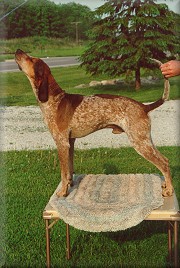
A person could almost say that the history of the English Coonhound is the history of all coonhounds - and he wouldn't be too far wrong. With the exception of the Plott Hound, all the U.K.C. breeds of coonhounds have a common ancestry that is deeply rooted in the English Foxhound.
The English was first registered by U.K.C. in 1905, under the name of English Fox & Coonhound. In those days the dogs were used much more on fox than they are today. The name also reflected this similarity that the breed had to the American Foxhound and the English Coonhound.
The variation in color brings us to another aspect of the English Coonhound history. Both the Treeing Walker and the Bluetick Coonhound were originally registered separate breed in 1945 and the Bluetick a year later. To this day there are still tri-colored and blueticked English hounds, though redticked dogs predominate.
The first mention we have of hounds in America appears in the diary of one of the men of the explorer DeSoto. He also mentions that the hounds were used for hunting Indians rather than fox, raccoon or rabbit.
In 1650, the Englishman Robert Brooke brought his pack of hounds with him. Thomas Walker of Virginia imported hounds from England in 1742, and in 1770 George Washington, and avid fox hunter, had hounds imported from England. These dogs were the foundation of the "Virginia Hounds", from which our present day English Coonhound developed.
It was however, for the Americans to adapt these animals to the much rougher American terrain and climate. And it was the Americans that, through careful breeding practices, adapted the hound to American game, the raccoon, opossum, cougar and various species of bear.
English hounds have excelled in both performance and conformation. The first major coonhound Field Trial of all time, the first Leafy Oak, was won by an English dog called "Bones", owned by Colonel Leon Robinson.
|
Plott Hound
|
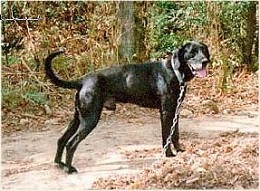
Of the six breeds of U.K.C. registered Coonhounds, only the Plott Hound doesn't trace its ancestry to the foxhound; and of all the breeds, we can be most certain of the Plott's heritage and the men most responsible for its development.
The ancestors of today's Plott were used for boar hunting in Germany many years ago. Jonathan Plott left his native Germany and came to this country in 1750. He brought a few wild boar hounds with him. These dogs had been bred for generations for their stamina and gameness. Plott and his family settled in the mountains of western North Carolina.
In those days there were no wild board in this country. Jonathan Plott used his dogs for hunting bears.
Plott supposedly kept his strain entirely pure, making no outcrosses. In 1780, the Plott pack passed into the hands of Henry Plott.
Shortly after that time a hunter living in Georgia who had been breeding his own outstanding strain of "leopard spotted bear dogs" heard of the fame of the Plott Hounds and came to North Carolina to see for himself. He was so impressed that he borrowed one of Plott's top stud dogs for a year to breed to his own bitches. This single cross is the only known instance of new blood being introduced into the Plott Hound since the first came to this country.
Other crosses possibly took place around the year 1900. G.P. Ferguson, who was a neighbor of the Plott family in North Carolina days, was a major influence on the Plott breed. He made a careful study of the Blevins hounds and the Cable hounds of that era. To what extent he used these bloodlines in his Plott breeding program, is not known.
The Plott Hound was first registered with United Kennel Club in 1946. Today's Plotts are know for their great courage and stamina. They have a clear voice that carries well.
|
Redbone
|
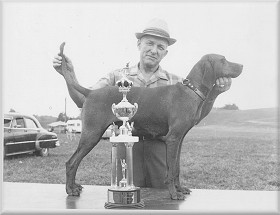
Years ago most coon hunters who owned a red dog of unknown ancestry, but proven ability in tracking and treeing raccoons, called his dog a "Redbone". Then a few serious breeders who were devoted both to the breed and the sport began a campaign of selective breeding to produce a hound with the necessary characteristics to make a superior coonhound and which would breed true to type in color and conformation.
The foundation stock of the modern day Redbone came from George F. L. Birdsong of Georgia, who was a noted foxhunter and breeder. He obtained the pack of Dr. Thomas Henry in the 1840's.
As is the case with most of the other coonhound breeds, the ancestors of the Redbone were foxhounds. A Bloodhound cross is said to have been made, and it's also said that the blood of the Irish hounds was also introduced later. This latter cross is said to account for the white chest and feet markings which still occasionally show up in Redbone pups today.
The first dogs were commonly called "Saddlebacks". The background color was red, and most of them possessed black saddle markings. By selective breeding, the black saddle was bred out and the solid red dogs became known as Redbone Coonhounds.
The Redbone was the second coonhound breed to be registered with U.K.C., the first being registered in 1902, two years after the American Black & Tan.
Of the six coonhound breeds, the Redbone is probably the most uniform as to type and size. The breed is distinguished by the medium build, pleading eyes and a "sweet" voice. The rich, deep red color makes the Redbone a striking dog to look at.
The Redbone is known to be a well-balanced breed, making them adaptable to various types of hunting and terrain. Their agility benefits them when hunting in fenced country or steep, rocky ground. Redbones are know to make excellent water dogs.
A natural treeing instinct has been bred into the Redbone, making them specialists in coon hunting. But they are also proficient in trailing and treeing bear, cougar and bobcat. Often times, when used on big game, Redbones are hunted in packs.
|